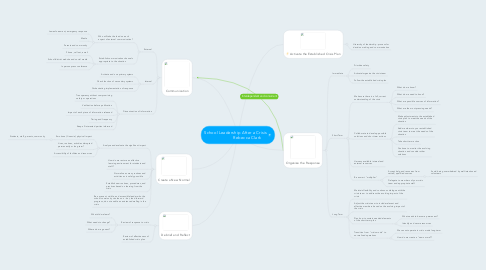
1. Organize the Response
1.1. Immediate
1.1.1. Prioritize safety
1.1.2. Activate/organize the crisis team
1.1.3. Follow the established crisis plan
1.2. Short Term
1.2.1. Make sure there is a full, current understanding of the crisis
1.2.1.1. What do we know?
1.2.1.2. What do we need to know?
1.2.1.3. What are possible sources of information?
1.2.1.4. What are the most pressing needs?
1.2.2. Collaborate to develop possible solutions and short term actions
1.2.2.1. Make adjustments to the established crisis plan to meet the needs of the situation
1.2.2.2. Add members to your established crisis team to meet the needs of the situation
1.2.2.3. Take short term action
1.2.2.4. Continue to monitor the evolving situation and consider other solutions
1.2.3. Harness available internal and external resources
1.2.4. Be a smart "multiplier"
1.2.4.1. Accept help and resources from vetted, qualified sources
1.2.4.1.1. Avoid being overwhelmed by well-intentioned volunteers
1.2.4.2. Delegate to members of your crisis team and appropriate staff
1.3. Long Term
1.3.1. Maintain flexibility and continuous dialogue with the crisis team to address the evolving impact of the crisis
1.3.2. Adjust the crisis team to include relevant and effective members based on the evolving impact of the crisis
1.3.3. Plan how to sustain needed elements of the short term plan
1.3.3.1. What needs to become permanent?
1.3.3.2. Identify and secure resources
1.3.4. Transition from "crisis mode" to normalized operations
1.3.4.1. We cannot operate in crisis mode long-term
1.3.4.2. How do we create a "new normal"?
2. Communication
2.1. External
2.1.1. Who will take the lead on each aspect of external communication?
2.1.1.1. Law enforcement, emergency response
2.1.1.2. Media
2.1.1.3. Parents and community
2.1.2. Establish communication channels appropriate to the situation
2.1.2.1. Phone, call out, email
2.1.2.2. School/district website and social media
2.1.2.3. In person press conference
2.2. Internal
2.2.1. Activate and use primary sytems
2.2.2. Check function of secondary systems
2.2.3. Orchestrating implementation of response
2.3. Dissemination of information
2.3.1. Transparency without compromising safety or operations
2.3.2. Verification before publication
2.3.3. Impact of each piece of information released
2.3.4. Timing and frequency
2.3.5. Keep all interested parties informed
3. Activate the Established Crisis Plan
3.1. Hierarchy of leadership - process for decision making and communication
4. Create a New Normal
4.1. Analyze and evaluate the significant impact
4.1.1. Emotional, financial, physical impact
4.1.1.1. Students, staff, parents, community
4.1.2. Lives, routines, activities disrupted permanently or long term?
4.1.3. Accessibility of facilities and resources
4.2. How do we restore an effective learning environment for students and staff?
4.3. Normalize as many routines and activities as is safely possible
4.4. Establish new routines, procedures, and practices based on learning from the crisis
4.5. Be a present, visible, and accessible leader who the school community can lean on - but, lead forward progress, do not enable an existence dwelling in the crisis
5. Debrief and Reflect
5.1. Review of response to crisis
5.1.1. What did we learn?
5.1.2. What needs to change?
5.1.3. Where do we go next?
